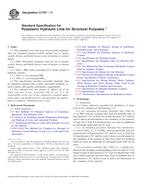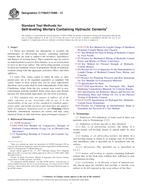We need your consent to use the individual data so that you can see information about your interests, among other things. Click "OK" to give your consent.
ASTM C1656-13
Standard Guide for Measuring the Reactivity of Hydraulic Refractory Castables using Exothermic Profile
STANDARD published on 1.4.2013
The information about the standard:
Designation standards: ASTM C1656-13
Note: WITHDRAWN
Publication date standards: 1.4.2013
SKU: NS-12129
The number of pages: 3
Approximate weight : 9 g (0.02 lbs)
Country: American technical standard
Category: Technical standards ASTM
The category - similar standards:
Annotation of standard text ASTM C1656-13 :
Keywords:
castable, refractory, exothermic profile, EP, working time, ICS Number Code 91.100.10 (Cement. Gypsum. Lime. Mortar)
Additional information
| Significance and Use | ||||||
|
4.1 The heat of hydration of a calcium aluminate based castable is liberated over a short period of time (as compared to Portland cement). This makes it easy to measure the heat profile using off-the-shelf thermocouple equipment. 4.2 The heat profile can be used to make inferences about the setting and strength gain behavior of a castable and sometimes the working time of a castable. 4.3 Factors that should be controlled when comparing two castables include: size, shape and mass of cast object, start temperature of the mix, temperature of environment, and the thermal conductivity of the environment. If these factors are held constant, then the two castables heat profiles can be compared. 4.4 The temperature increase created by the castable exothermic reaction shall be at least 2.0°C more than the normal fluctuation of the laboratory temperature so that the time of this increase is easily discernible to the user. 4.5 Varying the amount of cement in the castable, the amount of water, the type and quantity of admixtures, and so forth, will change the shape, maximum temperature and time to maximum temperature of the curve. 4.6 Following is an example of a curve generated for an LCC (see Fig. 1) that does exhibit two peaks, the first one marking the end of working time. In this curve one could also infer that the start temperature of the mix was 24°C and also that the hydraulic strength gain reaction was significantly started, but not completed by 6 h. |
||||||
| 1. Scope | ||||||
|
1.1 This guide applies to all castables with a reactive binder system that produces a measurable heat profile during the setting and hardening process. The majority of these systems will have calcium aluminate cement as one component of the binder system. 1.2 This standard does not purport to address all of the safety concerns, if any, associated with its use. It is the responsibility of the user of this standard to establish appropriate safety and health practices and to determine the applicability of regulatory limitations prior to use . |
||||||
| 2. Referenced Documents | ||||||
|
Similar standards:
Historical
1.11.2009
Historical
15.2.2009
Historical
1.6.2011
Historical
15.12.2013
Historical
1.8.2011
Historical
1.6.2012



 ASTM C1704/C1704M-09..
ASTM C1704/C1704M-09.. ASTM C1705/C1705M-09..
ASTM C1705/C1705M-09.. ASTM C1707-11
ASTM C1707-11 ASTM C1708/C1708M-13..
ASTM C1708/C1708M-13.. ASTM C1709-11
ASTM C1709-11 ASTM C1713-12
ASTM C1713-12 Cookies
Cookies
